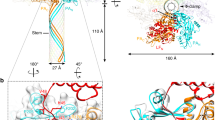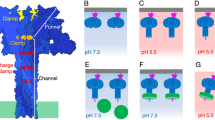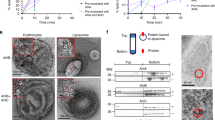Abstract
Protective antigen (PA) is the central component of the three-part protein toxin secreted by Bacillus anthracis, the organism responsible for anthrax1. After proteolytic activation on the host cell surface, PA forms a membrane-inserting heptamer that translocates the toxic enzymes, oedema factor and lethal factor, into the cytosol2–4. PA, which has a relative molecular mass of 83,000 (Mr 83K), can also translocate heterologous proteins, and is being evaluated for use as a general protein delivery system5,6. Here we report the crystal structure of monomeric PA at 2.1 Å resolution and the water-soluble heptamer at 4.5 Å resolution. The monomer is organized mainly into antiparallel β-sheets and has four domains: an amino-terminal domain (domain 1) containing two calcium ions and the cleavage site for activating proteases; a heptamerization domain (domain 2) containing a large flexible loop implicated in membrane insertion; a small domain of unknown function (domain 3); and a carboxy-terminal receptor-binding domain (domain 4). Removal of a 20K amino-terminal fragment from domain 1 allows the assembly of the heptamer, a ring-shaped structure with a negatively charged lumen, and exposes a large hydrophobic surface for binding the toxic enzymes. We propose a model of pH-dependent membrane insertion involving the formation of a porin-like, membrane-spanning β-barrel.
This is a preview of subscription content, access via your institution
Access options
Subscribe to this journal
Receive 51 print issues and online access
$199.00 per year
only $3.90 per issue
Buy this article
- Purchase on Springer Link
- Instant access to full article PDF
Prices may be subject to local taxes which are calculated during checkout
Similar content being viewed by others
References
Turnbull, P. in Topley and Wilson's Principles of Bacteriology, Virology and Immunity: Bacterial Diseases (eds Smith, G. R. & Easman, C. S. F.) 365–379 (Arnold, London, 1990).
Leppla, S. H. in Bacterial Toxins and Virulence Factors in Disease (eds Moss, J., Iglewksi, B., Vaughan, M. & Tu, A. T.) 543–572 (Dekker, New York, 1995).
Milne, J. C. & Collier, R. J. pH-dependent permeabilization of the plasma membrane of mammalian cells by anthrax protective antigen. Mol. Microbiol. 10, 647–653 (1993).
Milne, J. C., Furlong, D., Hanna, P. C., Wall, J. S. & Collier, R. J. Anthrax protective antigen forms oligomers during intoxication of mammalian cells. J. Biol. Chem. 269, 20607–20612 (1994).
Blanke, S. R., Milne, J. C., Benson, E. L. & Collier, R. J. Fused polycationic peptide mediates delivery of diphtheria toxin A chain to the cytosol in the presence of antrhrax protective antigen. Proc. Natl Acad. Sci. USA 93, 8437–8442 (1996).
Arora, N. & Leppla, S. H. Residues 1–254 of anthrax toxin lethal factor are sufficient to cause cellular uptake of fushed polypeptides. J. Biol. Chem. 268, 3334–3341 (1993).
Prasad, G. S. et al. Structure of toxic shock syndrome toxin-1. Biochemistry 32, 13761–13766 (1993).
Perelle, S., Gibert, M., Boquet, P. & Popoff, M. R. Characterization of Clostridium perfringens Iota-Toxin genes and expression in Escherichia coli. Infect. Immun. 61, 5147–5156 (1993).
Warren, G. et al. Novel pesticidal proteins and strains. World intellectual property organization. Patent application WO 96/10083 (1996).
Little, S. F. et al. Characterization of lethal factor-binding and cell-receptor binding domains of protective antigen of Bacillus anthracis using monoclonal antibodies. Microbiology 142, 707–715 (1996).
Novak, J. M., Stein, M.-P., Little, S. F., Leppla, S. H. & Friedlander, A. M. Functional characterization of protease-treated Bacillus anthracis protective antigen. J. Biol. Chem. 267, 17186–17193 (1992).
Singh, Y., Klimpel, K. R., Quinn, C. P., Chaudhary, V. K. & Leppla, S. H. The carboxyl-terminal end of protective antigen is required for receptor binding and anthrax toxin activity. J. Biol. Chem. 266, 15493–15497 (1991).
Choe, S. et al. The crystal structure of diphtheria toxin. Nature 357, 216–222 (1992).
Leppla, S. H. in Sourcebook of Bacterial Protein Toxins (eds Alouf, J. E. & Freer, J. H.) 277–302 (Academic, San Diego, 1991).
Blaustein, R. O., Koehler, T. M., Collier, R. J. & Finkelstein, A. Anthrax toxin: channel-forming activity of protective antigen in planar phospholipid bilayers. Proc. Natl Acad. Sci. USA 86, 2209–2213 (1989).
Zhao, J., Milne, J. C. & Collier, R. J. Effect of anthrax toxin's lethal factor on ion channels formed by the protective antigen. J. Biol. Chem. 270, 18626–18630 (1995).
Singh, Y., Klimpel, K. R., Arora, N., Sharma, M. & Leppla, S. H. The chymotrypsin-sensitive site, FFD3l5, in anthrax toxin protective antigen is required for translocation of lethal factor. J. Biol. Chem. 269, 29039–29046 (1994).
Song, L. et al. Structure of Staphylococcal α-hemolysin, a heptameric transmembrane pore. Science 274, 1859–1865 (1996).
Blaustein, R. O. & Finkelstein, A. Voltage-dependent block of anthrax toxin channels in planar phospholipid bilayer membranes by symmetric tetraalkylammonium ions. J. Gen. Physiol. 96, 905–919 (1990).
Kelly, J. W. Alternative conformations of amyloidogenic proteins govern their behavior. Curr. Opin. Struct. Biol. 6, 11–17 (1996).
Koehler, T. M. & Collier, R. J. Anthrax toxin protective antigen: low pH-induced hydrophobicity and channel formation in liposomes. Mol. Microbiol. 5, 1501–1506 (1991).
Otwinowski, Z. in Data collection and processing (eds Sawyer, L., Isaacs, N. & Bailey, S.) 56–62 (SERC Daresbury Laboratory, Warrington, UK, 1993).
Howard, A. J. et al. Software for a diffractometer with multiwire area detector. Methods Enzymol. 114, 452–472 (1985).
Otwinowski, Z. in Proceedings of the CCP4 Study Weekend: Isomorphous Replacement and Anomalous Scattering 80–85 (SERC Daresbury Laboratory, Warrington, UK, 1991).
Jones, T. A. A graphics model building and refinement system for macromolecules. J. Appl. Crystallogr. 11, 268–272 (1978).
Brünger, A. T. X-PLOR Manual, version 3.1 (Yale University, New Haven, CT, 1992).
Nakayama, S. & Kretsinger, R. H. Evolution of the EF-Hand family of proteins. Annu. Rev. Biophys. Biomol. Struct. 23, 473–507 (1994).
Kleywegt, G. & Jones, T. A. in From First Map to Final Model (eds Bailey, S., Hubbard, R. & Waller, D.) 59–66 (SERC Daresbury Laboratory, Warrington, UK, 1994).
Nicholls, A. GRASP: Graphical Representation and Analysis of Surface Properties (Columbia University, New York, 1992).
Kreusch, A., Neubüser, A., Schiltz, E., Weckesser, J. & Schultz, G. E. The structure of the membrane channel porin from Rhodopseudomonas blastica at 2.0 Å resolution. Protein Sci. 3, 58–63 (1994).
Author information
Authors and Affiliations
Rights and permissions
About this article
Cite this article
Petosa, C., Collier, R., Klimpel, K. et al. Crystal structure of the anthrax toxin protective antigen. Nature 385, 833–838 (1997). https://doi.org/10.1038/385833a0
Received:
Accepted:
Issue Date:
DOI: https://doi.org/10.1038/385833a0
This article is cited by
-
Structure and dynamics analysis of multi-domain putative β-1,4-glucosidase of family 3 glycoside hydrolase (PsGH3) from Pseudopedobacter saltans
Journal of Molecular Modeling (2021)
-
Molecular characterization of B. anthracis isolates from the anthrax outbreak among cattle in Karnataka, India
BMC Microbiology (2020)
-
Development of a novel multiepitope chimeric vaccine against anthrax
Medical Microbiology and Immunology (2019)
-
Bioinspired detoxification of blood: The efficient removal of anthrax toxin protective antigen using an extracorporeal macroporous adsorbent device
Scientific Reports (2018)
Comments
By submitting a comment you agree to abide by our Terms and Community Guidelines. If you find something abusive or that does not comply with our terms or guidelines please flag it as inappropriate.



